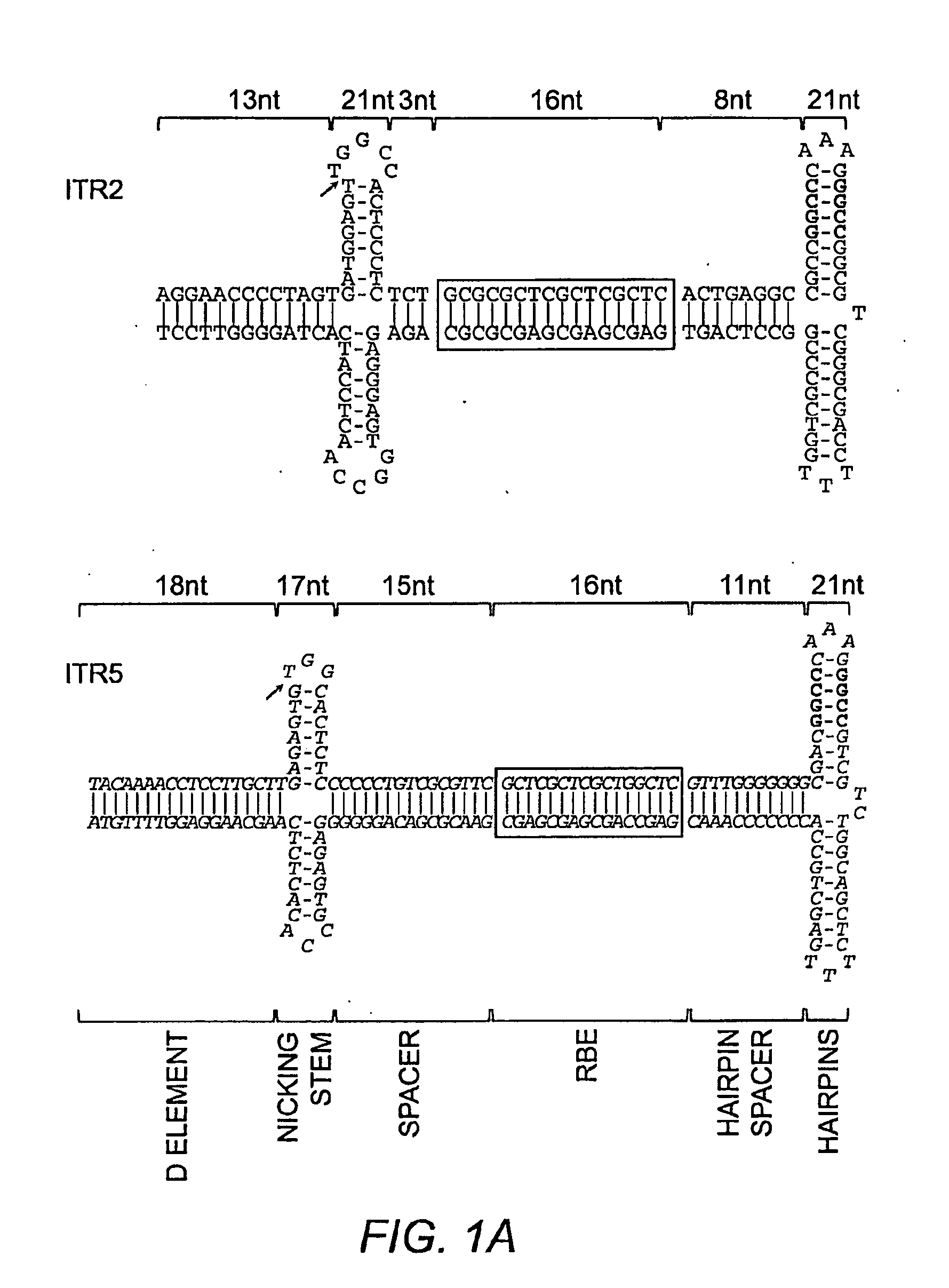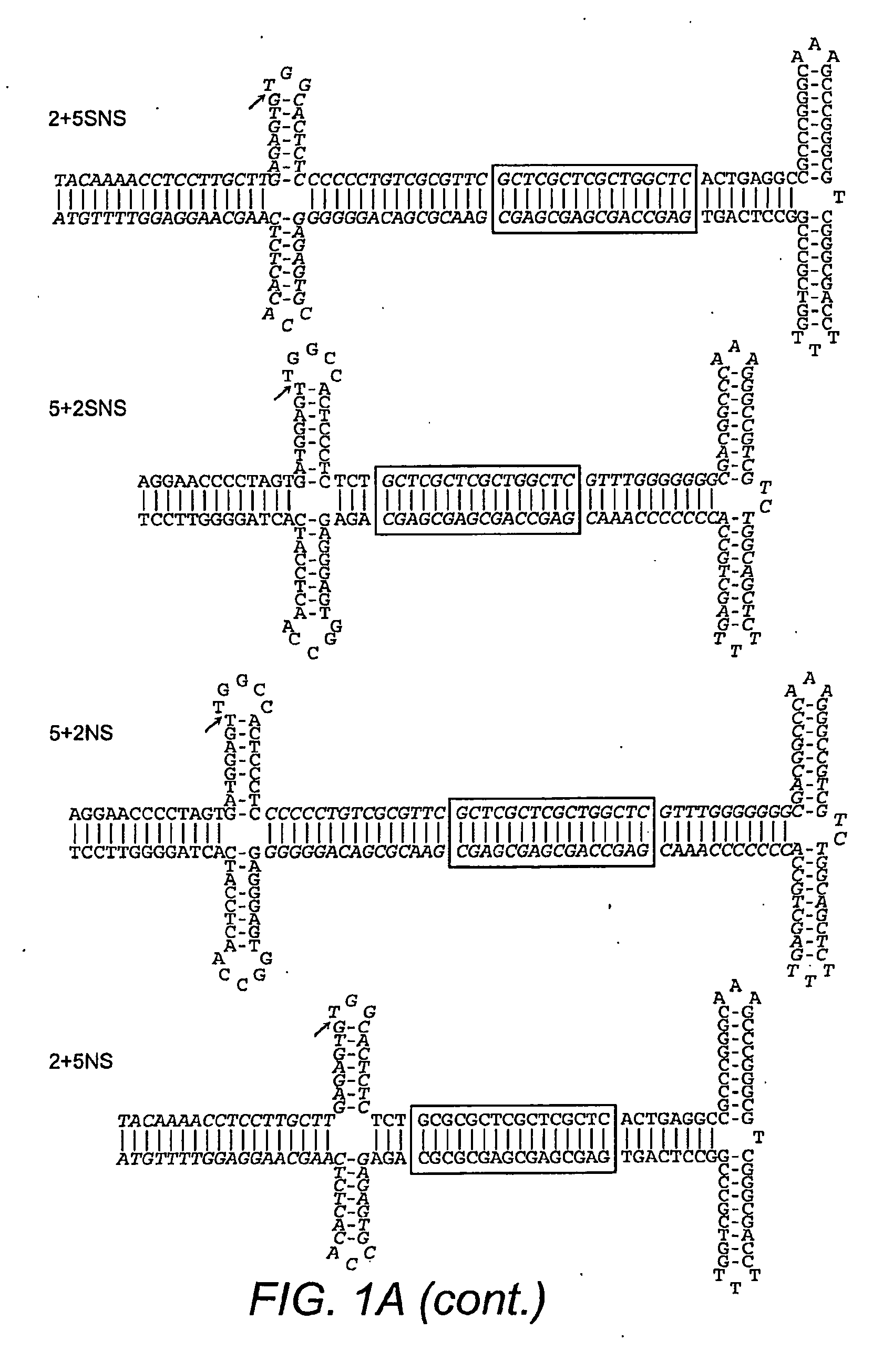Restrictive Inverted Terminal Repeats for Viral Vectors
a technology of inverted terminal repeats and viral vectors, applied in the field of modified parvovirus inverted terminal repeats, can solve the problems of latent infections and safety risks of using itr2s for therapeutic purposes
- Summary
- Abstract
- Description
- Claims
- Application Information
AI Technical Summary
Benefits of technology
Problems solved by technology
Method used
Image
Examples
example 1
Materials and Methods
[0256]Rep Cloning
[0257]pXR2 (Rep2Cap2) and pRep5Cap2 AAV helper plasmids served as templates for Rep cloning. The primer sequences used are indicated in Table 4. Two cloning strategies were used. Existing restriction sites were incorporated into primers for PCR (PCR-RD in Table 4) utilizing either pXR out fw or pXR out rev primers. PfuTurbo DNA Polymerase (Stratagene, La Jolla, Calif.) was used at the manufacturer's recommendations for all PCR reactions. PCR-RD products were digested with the enzymes indicated in Table 4 (NEB, Ipswich, Mass.) prior to ligation with T4 DNA Ligase (Invitrogen, Carlsbad, Calif.) according to the manufacturer's instructions. Alternately, an overlap-extension mediated PCR (OE-PCR) approach was used to produce Rep chimeras (Higuchi et al. (1988) Nucleic Acids Res. 16:7351). The Rep2 and Rep5 junction was incorporated into forward and reverse primers which were used in separate PCR reactions with the pXR out fw and rev primers (Table 4...
example 2
Construction and Characterization of Chimeric ITRs
[0270]Previously, AAV replicative specificity was postulated to be driven by the trs sequence (Chiorini et al. (1999) J. Virol. 73:4293; Chiorini et al. (1999) J. Virol. 73:1309). Rep2 can nick the ITR2 trs (AGT / TGG) and the AAVS1 trs of human chromosome 19 (GGT / TGG) (Wu et al. (2001) Arch. Biochem. Biophys. 389:271). Rep5 nicks only the ITR5 trs (AGTG / TGG). However, alignment of the ITR2 and ITR5 sequences revealed several significant sequence and structural differences outside the trs sequence (FIG. 1A). The spacing between the putative RBE and the nicking stem was significantly different; three nucleotides (nt) for ITR2 and 15 nt for ITR5. Additionally, while the trs sequence is not tightly conserved between ITR2 and ITR5, neither is the height or overall length of the putative nicking stem.
[0271]A novel method was used to generate mutant ITRs in order to determine which portions of the ITR were responsible for replicative specifi...
example 3
The Nicking Stem is Important for ITR5Specificity
[0277]ITR2+5NS (SEQ ID NO:22) established that Rep2 is capable of nicking an ITR with an ITR5 nicking stem and that Rep-ITR specificity is not driven exclusively by the trs sequence (FIG. 1B). In order to determine the flexibility of Rep2 toward mutant nicking stems, ITR2s containing altered forms of the hairpin were generated (FIG. 2A). Rep2 is able to replicate an ITR with an ITR5 nicking stem even though the ITR5 nicking stem contains a different trs sequence, is one by shorter, and has two fewer unpaired nucleotides at its tip (FIG. 2A). The substitution of the ITR5 nicking stem into ITR2 also allowed replication by Rep5.
[0278]To determine which element of the ITR2 nicking stem prevented Rep5 activity, specific portions of the ITR2 stem were altered. First, one by at the top of the putative ITR2 nicking stem was removed to lower the height to that of ITR5 (ITR2-TA, SEQ ID NO:23). Removing the T-A by also resulted in a trs resembli...
PUM
| Property | Measurement | Unit |
|---|---|---|
| pH | aaaaa | aaaaa |
| pH | aaaaa | aaaaa |
| pH | aaaaa | aaaaa |
Abstract
Description
Claims
Application Information
 Login to View More
Login to View More - R&D
- Intellectual Property
- Life Sciences
- Materials
- Tech Scout
- Unparalleled Data Quality
- Higher Quality Content
- 60% Fewer Hallucinations
Browse by: Latest US Patents, China's latest patents, Technical Efficacy Thesaurus, Application Domain, Technology Topic, Popular Technical Reports.
© 2025 PatSnap. All rights reserved.Legal|Privacy policy|Modern Slavery Act Transparency Statement|Sitemap|About US| Contact US: help@patsnap.com



